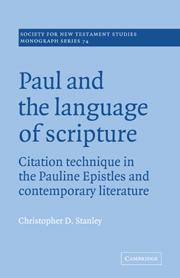 Paul and the Language of Scripture
Paul and the Language of Scripture 8 - Citation technique in early Judaism
Published online by Cambridge University Press: 05 November 2011
Summary
Introduction
Countless studies have sought to correlate the apostle Paul's handling of Scripture with the methods of his Jewish contemporaries. In addition to the summary treatments that accompany most investigations of Paul's use of the “Old Testament,” a variety of monographs have compared Paul's mode of interpretation with those of Philo, the rabbinic literature, and the Qumran community. Similar investigations have been carried out for every book of the New Testament where biblical quotations can be identified. Additional studies have examined the interpretational techniques of the Jewish materials themselves. After so much scholarly effort, one would expect to find a wealth of data on the way early Jewish writers handled the wording of their quotations. In reality, very few researchers have concerned themselves with this problem. Several explanations can be posited for this comparative neglect: the complex and uncertain text-history of the biblical materials themselves; the difficulty of fixing an individual author's biblical Vorlage; the loss of original language versions of many of the works in question; a notable lack of comparative studies on other documents; and especially the higher visibility and relative accessibility of an author's exegetical techniques as compared to the way he handled the wording of Scripture. Comparing hermeneutical models is certainly a more promising enterprise than entering into a labyrinthine discussion of the relationship between a series of quotations and their presumed biblical Vorlage. In the long run, however, there is no escaping the close analysis that is required to render an adequate portrait of an author's approach to the biblical text.
Information
- Type
- Chapter
- Information
- Paul and the Language of ScriptureCitation Technique in the Pauline Epistles and Contemporary Literature, pp. 292 - 337Publisher: Cambridge University PressPrint publication year: 1992